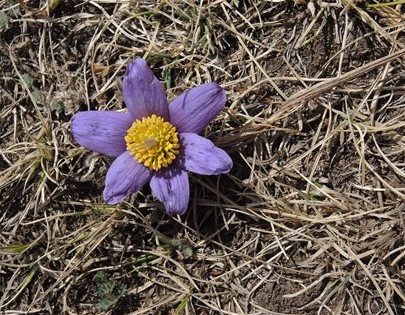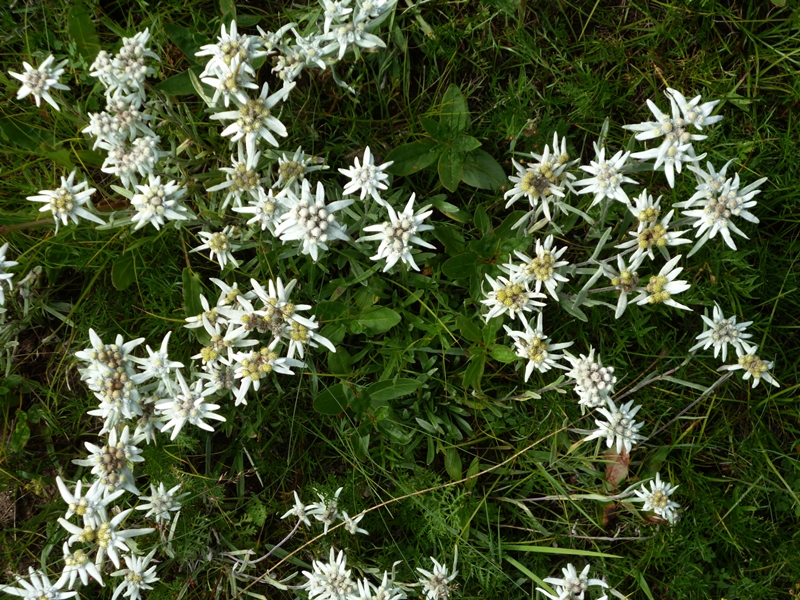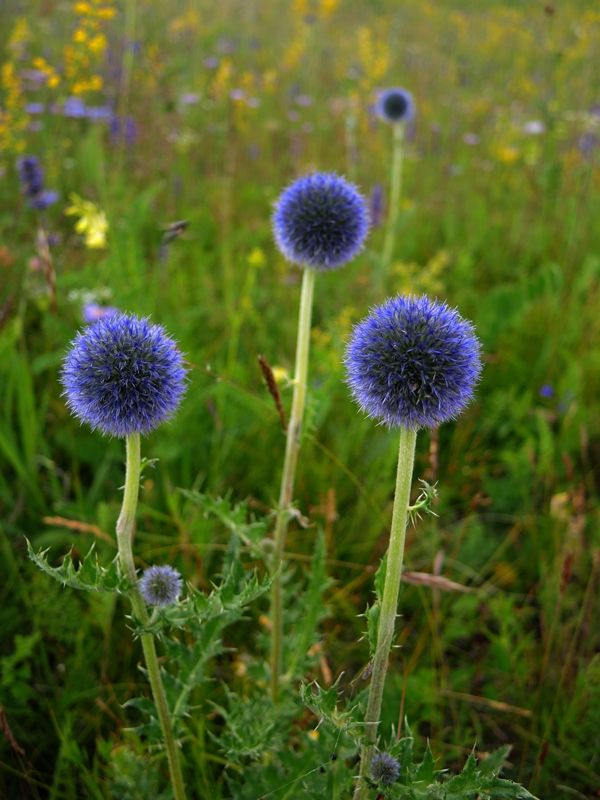No products in the cart.
Wildflowers of Gorkhi Terelj National Park
A Visual Feast for Horse Riders in Gorkhi Terelj National Park
– and a Real Feast for Trail Riding Expedition Horses in Mongolia
Wildflowers of Gorkhi Terelj National Park are one of the great attractions of this scenic park of Mongolia. The very first flowers start out in May, just with the first warm days when the sun begins to warm the ground and the soil has moisture from winter snow cover, or a recent spring snow fall. I have seen how on a sunny mountain slope the snow began to melt in the daytime, and with a few cycles of daytime melting and nighttime freezing a cover of thin ice as clear as glass formed above the ground in many places, acting like little greenhouses warming spots of soil below that may offer conditions for first plant growth.

Wildflowers of early Spring Time in Mongolia
Anemonies are among the early and most striking flowers. Often enough they will bloom in the snow, one may see a whole field of the yellow anemonies (pulsatilla alpina) contrasted against the white ground. More visible even are the purple pasque flowers often seen on the spring time ground that is still grey and nearly bare of other vegetation. Spring time weather is closely watched by herders to forecast the growth of vegetation so much needed by the livestock that made it through the harsh Mongolian winter and that now have off spring. A spring snow fall followed by warm weather is a welcome weather pattern, giving moisture and warmth to the soil for grass to grow. Blue patches of iris are another feature, typically seen in lowlands, along streams, blooming throughout June.
Preparing Horses for the Riding Season in Gorkhi Terelj National Park

Like all livestock, the horses are eager to graze on the fresh grass of spring time. With good grass, one can see them putting on weight by the day, and watch them feeling it. This is the time of spontaneous runs and jumps and kicking their heels, particularly the young horses – but even the older ones seem to get overwhelmed by energy and good feelings and its great to watch. And everybody with a horse as a close companion has experienced that energy he gets from fresh green grass in spring time; all of a sudden he is so light in his feet, the life in him is so strong, he is ready to go and more than happy to go for a run. Its that energy and strength that we want our horses to gain before we even set out on the first riding expeditions with guests to venture once again into Gorkhi Terelj National Park and later in the season into the Khentii Mountains. Hay and grain keep the herd in fair condition all winter long, but nothing beats fresh grasses, herbs and forbes that the pastures of Mongolia have to offer. By the time we start the guided horse treks, the horses are strong but past these spring time bursts of energy.

The Height of Wildflower Season in Mongolia’s Grasslands
For months to come, the mountain meadows of Gorkhi Terelj National Park will be great grazing grounds for horses on riding expeditions. And for guests, they will be a feast for the eyes, exploding in the colors of wildflowers. Fields of white and blue and yellow, dotted with red blooms are common sights in July and August. Blue columbines, yellow poppies, geraniums, are common, and – there may be no place else with such an abundance of edelweiss as in the high country grasslands of Mongolia’s northern and central regions.
Video of Horse Riding and Wildflowers of Gorkhi Terelj National Park

On a horse riding tour with Stone Horse Expeditions you will experience the abundance and diversity of Mongolian wildflowers in Gorkhi Terelj National Park; these tours bring you way back into the remote parts of the park, or further into the wilderness of the Khan Khentii on our “deep wilderness” expedition. July through August is the height of wildflower season (followed by fantastic autumn colors that are no less amazing).
Enjoy a short video that highlights the wildflowers of Gorkhi Terelj National Park.
Resources on Wildflowers of Gorkhi Terelj National Park
For more information on wildflowers of Gorkhi Terelj National Park, there are some good resources catering to both more popular interest as well as providing very comprehensive botanical information on Mongolia’s wildflower species. Here are some of the resources:
Wildflowers of Northern Mongolia
A great little book made for the Huvsgul region in the Northern Mongolia, but many of the plant species are to be found in Gorkhi Terelj National Park as well. The authors are Jamsran Oyumaa and Claudia Rector. Find it here: http://www.nhbs.com/wildflowers_of_northern_mongolia_tefno_140738.html
Flowers of Mongolia
A comprehensive book, with lots of botanical information and great photos, created by the collaboration of Mongolian (Zeerd-Aduuchid B Solongo) and German botanists – (Michael H Hauck). Available here: http://www.nhbs.com/flowers_of_mongolia_tefno_175759.html
Virtual Guide to the Flora of Mongolia
This is a scientific resource, an online herbarium that represents a comprehensive plant database for Mongolia. Explore it here: http://greif.uni-greifswald.de/floragreif/?cat=10 (Virtual Guide to the Flora of Mongolia. Plant Database as Practical Approach)
Forage Plants in Mongolia
Our horses’ favorite book (though they have memorized most of the species) – the 563-page book “Forage Plants in Mongolia,” authored by S. Jigjidsuren (Research Institute of Animal Husbandry, Ulaanbaatar, Mongolia) and Douglas A. Johnson, describes the botanical details of morethan 300 forage plant species from the rich, diverse flora of Mongolia. This work was facilitated through joint U.S.-Mongolia germplasm collection expeditions undertaken in 1994, 1996, and 1998. Local names of plants noted in the book help preserve Mongolian herders’ traditional knowledge. Available at: http://www.amazon.com/Forage-Plants-in-Mongolia/dp/B000GGPTBI
Palatability of Mongolian Rangeland Plants
No photos, but a great resource for studies and management of range lands and livestock in Mongolia. Provides details on palatability of rangeland plants, characterizing them as P = preferred, D = desirable, U = consumed but undesirable, N = not consumable, T = toxic. Information is presented on 1044 plant species (131 grasses, 50 grass-like plants (sedges and rushes), 664 forbs, 161 shrubs/semishrubs, 17 woody/tree species and 8 lichen species found in Mongolia. About 13,700 evaluations were included in this document. Camel, cattle/yaks, elk (Cervus elaphus sibiricus), deer (Moschus moschiferus), goat, horse, sheep, and reindeer (Rangifer tarandus) were the assigned herbivores to evaluate palatability for each species. Reference: Damiran, D. 2005. Palatability of Mongolian Rangeland Plants. Circular of Information No. 3.Union, OR, USA: Eastern Oregon Agricultural Research Center, Oregon State University. 91 p. Download it at: http://ir.library.oregonstate.edu/xmlui/handle/1957/3087
Come Horse Riding in Mongolia – Join a Horseback Riding Tour in Gorkhi Terelj National Park with Stone Horse Expeditions & Travel!
Book a Horse Riding Tour in July or August to see the Wildflowers!
Check out other National Parks worldwide, and read about the best gear for trekking in these parks that preserve magnificent natural landscapes and wildlife habitat on our planet.



